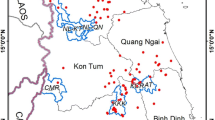Abstract
Climate change and global warming are the main challenges regarding to the conservation biologists on the world. Reptiles are ectothermic animal and then highly dependent on the habitat temperature and precipitation. To protect reptiles, it is necessary to predict the impact of climate change effect on the species distribution and manage its conservation program. In this study, we aimed to evaluate the impact of climate change on the distribution pattern of Paralaudakia lehmanni in Central Asia. According to the results, the current distribution is predicted from North Afghanistan, Tajikistan, and Kyrgyzstan and the precipitation of coldest quarter (BIO19) was the most contributed bioclimate variable. Future predictions show a similar pattern with the current period and, based on the niche overlap test, the overlap of these patterns was more than 0.85 and indicated no differences between them. Distribution can be affected by the highland distribution of P. lehmanni. Because this species has such an elevated range, precipitation of coldest quarter is not predicted to change much in future and therefore suitable habitats will remain similar to current period. Finally, although there is no predicted impact of climate change on the species distribution pattern in future, the conservation of P. lehmanni is important because of other threats such as human disturbance and predation.
Similar content being viewed by others
References
Anan’eva, N.B. and Golynskii, E.A., Analysis of distribution of the Turkistan rock agama, Paralaudakia lehmanni (Nikolsky, 1896): Using of MAXENT modeling, Tr. Zool. Inst., Ross. Akad. Nauk, 2013, vol. 317, no. 4, pp. 426–437.
Araujo, M.B., Thuiller, W., and Pearson, R.G., Climate warming and the decline of amphibians and reptiles in Europe, J. Biogeogr., 2006, vol. 33, pp. 1712–1728.
Blair, M.E., Sterling, E.J., Dusch, M., Raxworthy, C.J., and Pearson, R.G., Ecological divergence and speciation between lemur (Eulemur) sister species in Madagascar, J. Evol. Biol., 2013, vol. 26, pp. 1790–1801.
Colwell, R.K., Brehm, G., Cardelus, C.L., Gilman, A.C., and Longino, J.T., Global warming, elevational range shifts, and lowland biotic attrition in the wet tropics, Science, 2008, vol. 322, pp. 258–261.
Duffy, J.E., Why biodiversity is important to the functioning of real-world ecosystems, Front. Ecol. Environ., 2009, vol. 7, pp. 437–444.
Hijmans, R.J. and Graham, C.H., The ability of climate envelope models to predict the effect of climate change on species distributions, Global Change Biol., 2006, vol. 12, pp. 2272–2281.
Hijmans, R.J., Cameron, S.E., Parra, J.L., Jones, P.G., and Jarvis, A., Very high resolution interpolated climate surfaces for global land areas, Int. J. Climatol., 2005, vol. 25, pp. 1965–1978.
Hirzel, A.H., Le Lay, G., Helfer, V., Randin, C., and Guisan, A., Evaluating the ability of habitat suitability models to predict species presences, Ecol. Model., 2006, vol. 199, pp. 142–152.
Malcolm, J.R., Liu, C., Neilson, R.P., Hansen, L., and Hannah, L.E.E., Global warming and extinctions of endemic species from biodiversity hotspots, Conserv. Biol., 2006, vol. 20, pp. 538–548.
Manel, S., Williams, H.C., and Ormerod, S.J., Evaluating presence–absence models in ecology: the need to account for prevalence, J. Appl. Ecol., 2001, vol. 38, pp. 291–931.
Pearson, R.G. and Dawson, T.P., Predicting the impacts of climate change on the distribution of species: are bioclimate envelope models useful? Global Ecol. Biogeogr., 2003, vol. 12, pp. 361–371.
Phillips, S.J., Anderson, R.P., and Schapire, R.E., Maximum entropy modeling of species geographic distributions, Ecol. Model., 2006, vol. 190, pp. 231–259.
Solomon, S., Plattner, G.K., Knutti, R., and Friedlingstein, P., Irreversible climate change due to carbon dioxide emissions, Proc. Natl. Acad. Sci. U.S.A., 2009, vol. 106, pp. 1704–1709.
Warren, D.L., Glor, R.E., and Turelli, M., ENMTools: a toolbox for comparative studies of environmental niche models, Ecography, 2010, vol. 33, pp. 607–611.
Wisz, M.S., Pottier, J., Kissling, W.D., Pellissier, L., Lenoir, J., Damgaard, C.F., and Heikkinen, R.K., The role of biotic interactions in shaping distributions and realized assemblages of species: implications for species distribution modeling, Biol. Rev. Cambridge Philos. Soc., 2013, vol. 88, pp. 15–30.
Author information
Authors and Affiliations
Corresponding author
Additional information
The article is published in the original.
Rights and permissions
About this article
Cite this article
Sancholi, N. Effects of Climate Change on Paralaudakia lehmanni (Nicolsky, 1896) (Reptilia: Agamidae) in Central Asia. Contemp. Probl. Ecol. 11, 682–686 (2018). https://doi.org/10.1134/S199542551806015X
Received:
Accepted:
Published:
Issue Date:
DOI: https://doi.org/10.1134/S199542551806015X




